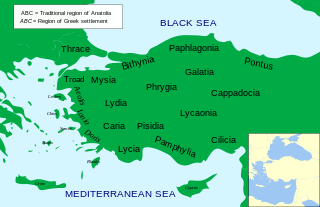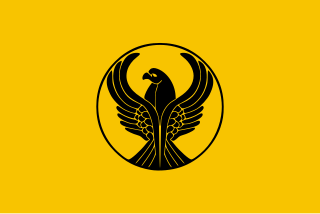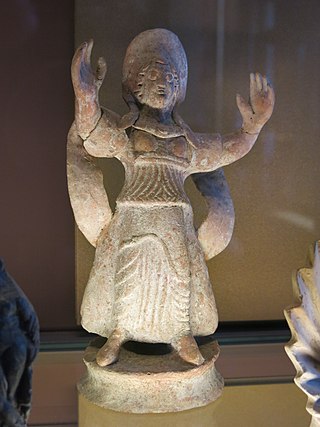
Paphlagonia was an ancient region on the Black Sea coast of north-central Anatolia, situated between Bithynia to the west and Pontus to the east, and separated from Phrygia by a prolongation to the east of the Bithynian Olympus. According to Strabo, the river Parthenius formed the western limit of the region, and it was bounded on the east by the Halys River. Paphlagonia was said to be named after Paphlagon, a son of the mythical Phineus.

The Pontic Greeks, also Pontian Greeks or simply Pontians, are an ethnically Greek group indigenous to the region of Pontus, in northeastern Anatolia. Many later migrated in various waves between the Ottoman conquest of the Empire of Trebizond in 1461 and the Russo-Turkish War of 1828–1829. Common migratory destinations included other parts of Eastern Anatolia, the former Russian province of Kars Oblast in the Transcaucasus, and the country of Georgia.

Mithridates or Mithradates V Euergetes was a prince and the seventh king of the wealthy Kingdom of Pontus.
Comana Pontica, was an ancient city located in ancient Pontus, on the river Iris, at modern Gümenek near Tokat in Turkey.

Korgan is a town and district of Ordu Province in the Black Sea region of Turkey. According to the 2000 census, the population of the district is 41,628 of which 15,587 live in the town of Korgan. The district covers an area of 233 km2 (90 sq mi), and the town lies at an elevation of 673 m (2,208 ft).

Fatsa is a town and a district of Ordu Province in the central Black Sea region of Turkey. Population from Fatsa is more than 115,000.
Taşova is a town in Amasya Province of the central Black Sea region of Turkey. It is the seat of Taşova District. Its population is 11,248 (2021). The altitude of the town is 230 meters. The mayor is Bayram Öztürk (AKP).

Bithynia and Pontus was the name of a province of the Roman Empire on the Black Sea coast of Anatolia. It was formed during the late Roman Republic by the amalgamation of the former kingdoms of Bithynia and Pontus. The amalgamation was part of a wider conquest of Anatolia and its reduction to Roman provinces.

The Amasya trials in 1921, were special ad hoc trials, organized by the Turkish National Movement, with the purpose to kill en masse the Greek representatives of Pontus region under a legal pretext. They occurred in Amasya, modern Turkey, during the final stage of the Pontic Greek genocide. The total number of the executed individuals is estimated to be ca. 400-450, among them 155 prominent Pontic Greeks.
Tenba was a town of ancient Bithynia near the coast of the Pontus Euxinus inhabited during Roman times. Its name does not occur in ancient authors, but is inferred from epigraphic and other evidence.
Libiopolis was a town in ancient Pontus on the Black Sea coast.
Virasia was a town in the west of ancient Pontus, inhabited in Byzantine times. According to the Tabula Peutingeriana it was on the road from Antoniopolis through Anadynata to Amasia, 16 M.P. from the latter.
Cromen was a town in the west of ancient Pontus, inhabited in Roman and Byzantine times. According to the Tabula Peutingeriana it was 11 M.P. from Amasia.
Diacopa or Diakopa was a town in the west of ancient Pontus, inhabited in Hellenistic and Roman times. The town gave its name to a region of Pontus called the Diacopene.
Sibora, also possibly called Foroba, was a town of ancient Pontus, inhabited in Roman and Byzantine times.
Syderos was a town of ancient Pontus, inhabited during Roman and Byzantine times.
Pida, or Pidae or Pidis, was a town of ancient Pontus, inhabited during Roman and Byzantine times. It was in the later province of Pontus Galaticus, on the road leading from Amasia to Neocaesareia.
Saurania, or Sauronisena, or Saunaria (Σαυναρία), was a town of ancient Pontus, inhabited during Roman and Byzantine times. It was in the later province of Pontus Polemoniacus, and mentioned by Ptolemy.
Anniaca was a town of ancient Pontus, inhabited during Byzantine times.
This page is based on this
Wikipedia article Text is available under the
CC BY-SA 4.0 license; additional terms may apply.
Images, videos and audio are available under their respective licenses.






